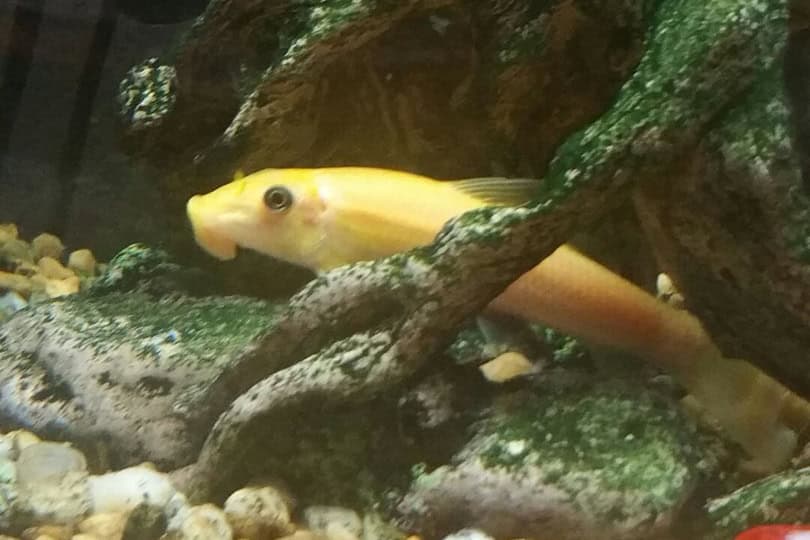Siamese Algae Eater vs Chinese Algae Eater: Similarities & Differences
The Siamese Algae Eater, also known as Crossocheilus oblongus, is a slender fish with a streamlined body. It typically has a black or dark brown coloration with a horizontal stripe running from its head to its tail. The Chinese Algae Eater, on the other hand, known as Gyrinocheilus aymonieri, has a more robust body shape and can grow larger than the Siamese Algae Eater. It has a light brown or golden coloration with a mottled pattern on its body.
Both fish have sucker-like mouths that they use to scrape algae off surfaces. However, the Siamese Algae Eater has a more pronounced mouth structure, making it more efficient at removing algae. The Chinese Algae Eater, although also capable of eating algae, is more opportunistic and may not be as effective at controlling algae growth in the aquarium.
Appearance
The Siamese Algae Eater has a slender body with a silver or gold coloration. It has a black horizontal stripe that runs from its nose to the base of its tail. This stripe is one of its distinguishing features. The Siamese Algae Eater grows up to 6 inches (15 cm) in length.
The Chinese Algae Eater, also known as Gyrinocheilus aymonieri, has a more robust body shape compared to the Siamese Algae Eater. It has a dark brown or black coloration with a lighter underside. One of its notable features is its sucker-like mouth, which it uses to attach itself to surfaces. The Chinese Algae Eater can grow up to 10 inches (25 cm) in length.
In addition to their physical characteristics, the Siamese Algae Eater and the Chinese Algae Eater also have distinct behavioral differences. While both species are known for their ability to consume algae, their feeding habits and preferences vary.
The Siamese Algae Eater is primarily herbivorous and feeds on various types of algae, including filamentous and green spot algae. It is an active swimmer and constantly moves around the aquarium in search of food. Due to its slender body shape, it is able to navigate through tight spaces and reach algae that may be inaccessible to other fish species.
On the other hand, the Chinese Algae Eater has a more opportunistic feeding behavior. While it does consume algae, it is also known to feed on other food sources such as fish flakes, pellets, and even small invertebrates. Its sucker-like mouth allows it to scrape algae off surfaces, but it can also use it to rasp on the scales of other fish, causing irritation and potential harm.
Both the Siamese Algae Eater and the Chinese Algae Eater are popular choices for aquarium enthusiasts looking for natural algae control. However, it is important to consider their specific dietary requirements and behaviors when selecting them as tank mates for other fish species. Providing a balanced diet and monitoring their interactions with other fish can help ensure a harmonious and healthy aquarium environment.
Behavior
When it comes to behavior, the Siamese Algae Eater is generally peaceful and can be kept in a community aquarium. It is an active fish that constantly moves around the tank in search of algae. It is known to be a voracious eater and can quickly consume large amounts of algae.
The Chinese Algae Eater, on the other hand, has a more aggressive temperament. While it may initially eat algae when young, it tends to become less interested in algae as it matures. Instead, it may start to feed on the slime coat of other fish or even attack their fins. This aggressive behavior makes the Chinese Algae Eater less suitable for community aquariums.
It is important to note that the behavior of these two algae eaters can also be influenced by their environment. Factors such as tank size, water quality, and the presence of other fish can all play a role in shaping their behavior. For example, if the tank is too small or overcrowded, both the Siamese and Chinese Algae Eaters may become territorial and aggressive. On the other hand, if the tank is spacious and well-maintained, they are more likely to exhibit their natural behavior of algae consumption.
In terms of compatibility with other fish species, the Siamese Algae Eater is generally considered to be more peaceful. It can coexist with a variety of community fish, including tetras, gouramis, and livebearers. However, it is important to avoid keeping them with aggressive or fin-nipping species, as they may become targets of aggression.
On the contrary, the Chinese Algae Eater is known to be more territorial and aggressive towards other fish. It may not only feed on the slime coat of other fish but also become territorial over certain areas of the tank. This can lead to conflicts with other bottom-dwelling fish or fish that prefer similar hiding spots. Therefore, it is generally recommended to keep the Chinese Algae Eater in a species-only tank or with other robust and aggressive fish species.
Overall, understanding the behavior of these algae eaters is crucial for creating a harmonious and balanced aquarium ecosystem. Proper tank setup, appropriate tank mates, and regular monitoring of their behavior can all contribute to the well-being and longevity of these fascinating fish.
Care Requirements
Both the Siamese Algae Eater and the Chinese Algae Eater have similar care requirements in terms of water parameters. They prefer a well-maintained aquarium with clean water and good filtration. The temperature should be kept between 75-80°F (24-27°C), and the pH level should be around 6.5-7.5.
When it comes to diet, the Siamese Algae Eater is primarily herbivorous and feeds on algae. However, it is important to note that it may not eat all types of algae and may require supplemental feeding with algae wafers or blanched vegetables. This is especially important in aquariums where there is a limited amount of algae available for the fish to consume. Algae wafers can be found at most pet stores and are specifically formulated to provide the necessary nutrients for algae-eating fish.
The Chinese Algae Eater, as mentioned earlier, may become less interested in algae as it matures. It is known to be an opportunistic feeder and may eat other types of food, including fish flakes, pellets, and frozen or live foods. However, it is important to provide a balanced diet to prevent nutritional deficiencies. A diet consisting solely of algae may not provide all the necessary nutrients for the fish’s overall health and wellbeing. Therefore, it is recommended to offer a variety of foods to ensure that the Chinese Algae Eater receives a balanced diet.
In addition to their dietary needs, both the Siamese Algae Eater and the Chinese Algae Eater require adequate hiding places in the aquarium. These fish are known to be territorial and may become aggressive towards other fish if they feel threatened or if their territory is invaded. Providing plenty of hiding places, such as caves, plants, or driftwood, can help alleviate any potential aggression and provide the fish with a sense of security.
Regular water changes are also important for the health of both the Siamese Algae Eater and the Chinese Algae Eater. These fish produce waste that can contribute to poor water quality if not properly managed. Performing regular water changes, typically around 20% every one to two weeks, can help maintain good water quality and prevent any potential health issues.
Compatibility with Other Fish
The Siamese Algae Eater is generally a peaceful fish and can be kept with a variety of other community fish. However, it is important to note that it may become territorial towards its own species, especially in smaller aquariums. Providing ample hiding spots and space can help alleviate any aggression.
The Chinese Algae Eater, as mentioned earlier, can be aggressive towards other fish, especially as it matures. It is not recommended to keep them with slow-moving or long-finned fish, as they may become targets of aggression. It is best to keep them in a species-only tank or with larger, more robust fish that can hold their own.
When considering compatibility with other fish, it is important to take into account the specific needs and behaviors of each species. Some fish are more territorial or aggressive by nature, while others are more peaceful and social. It is crucial to create a harmonious community tank by selecting fish that have similar temperaments and habitat requirements.
In addition to the Siamese Algae Eater and Chinese Algae Eater, there are several other fish species that are known to be compatible with a variety of community fish. For example, the Neon Tetra is a small, peaceful fish that can be kept with a wide range of other species, including guppies, mollies, and rasboras.
Another popular choice for community tanks is the Corydoras catfish. These bottom-dwelling fish are known for their peaceful nature and can be kept with a variety of other fish, such as tetras, angelfish, and gouramis. They are also excellent algae eaters, making them a great addition to any aquarium.
When introducing new fish to a community tank, it is important to acclimate them properly to reduce stress and minimize the risk of aggression. This can be done by gradually adjusting the water parameters and temperature over a period of time. It is also advisable to quarantine new fish before adding them to the main tank to ensure they are healthy and free from any diseases.
Summary
Overall, creating a compatible community tank requires careful consideration of each fish’s temperament, size, and habitat requirements. By selecting fish that are compatible with one another, providing ample hiding spots and space, and acclimating new fish properly, you can create a thriving and harmonious aquarium environment.

